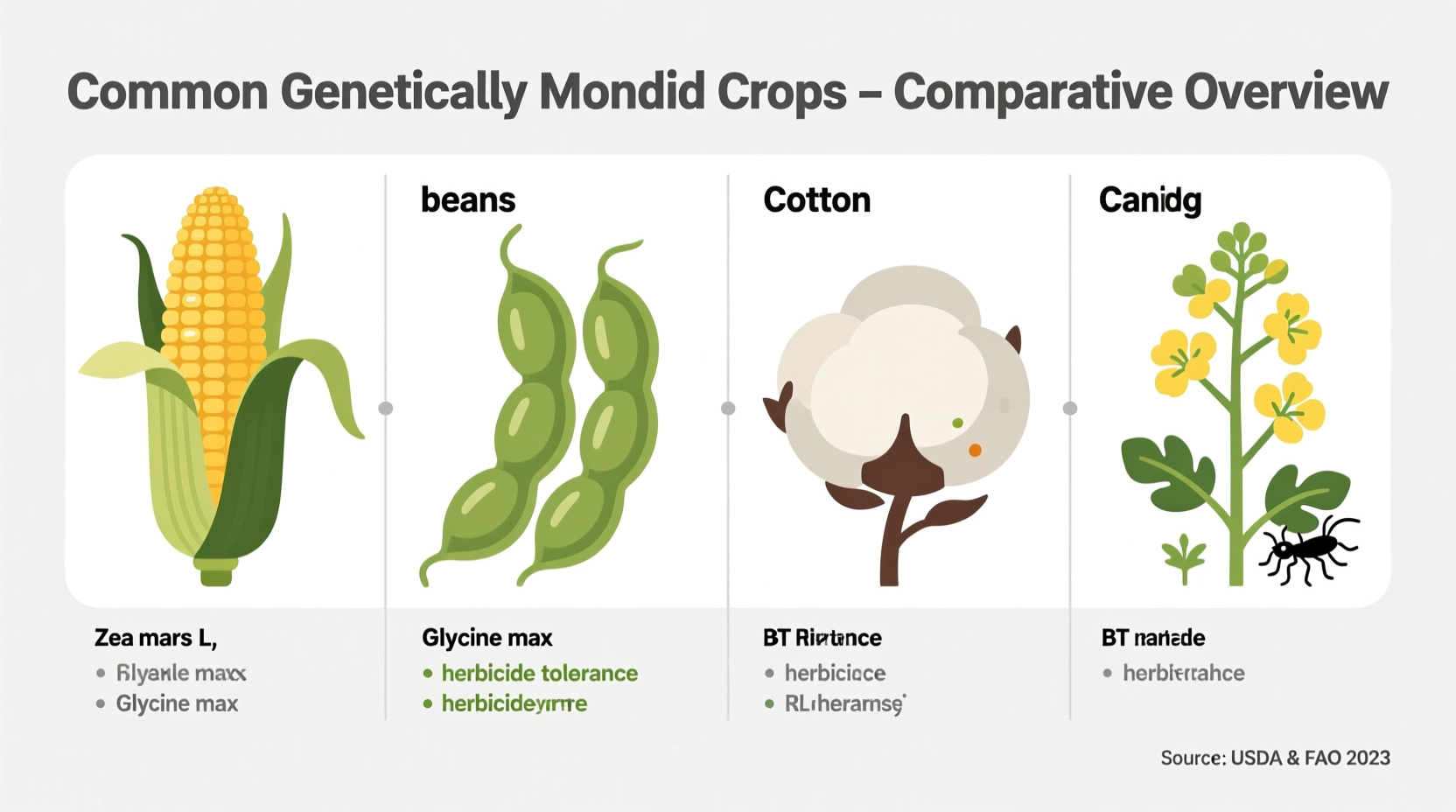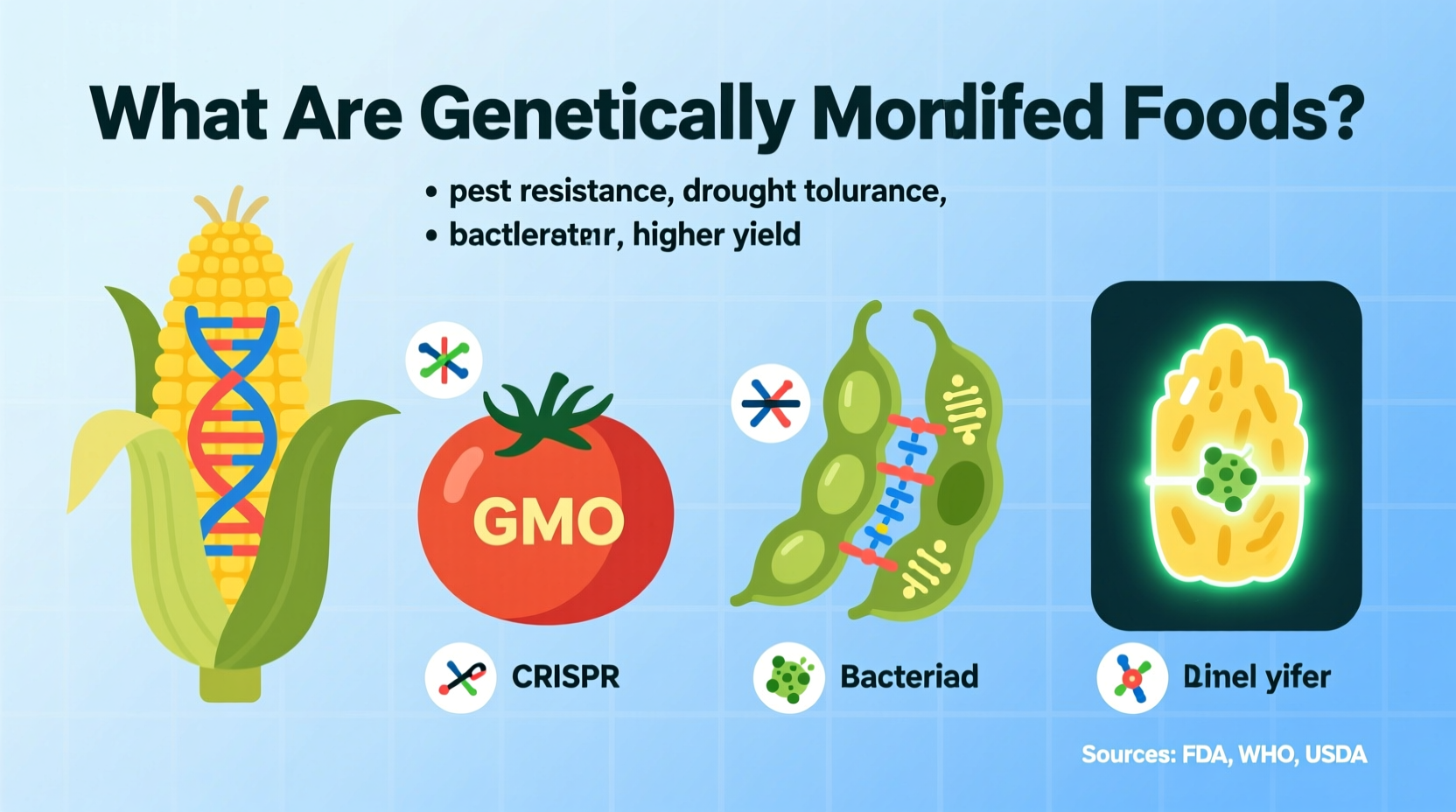Understanding which foods contain genetically modified organisms (GMOs) is essential for making informed dietary choices. This comprehensive guide reveals exactly which foods are genetically modified, where they're grown, how to identify them, and what it means for your shopping decisions. You'll gain practical knowledge to navigate grocery aisles with confidence and understand the real scope of GMO presence in our food system.
Top 9 Commercially Available GMO Crops: The Complete List
While "genetically modified foods" might sound like a vast category, only nine crops have received full commercial approval for human consumption worldwide. These genetically engineered varieties were developed primarily for herbicide tolerance or insect resistance, fundamentally changing agricultural practices since their introduction in the mid-1990s.
| Crop | Primary Modification | U.S. Adoption Rate | Major Producing Countries |
|---|---|---|---|
| Soybeans | Herbicide tolerance | 94% | USA, Brazil, Argentina, Paraguay |
| Corn | Herbicide tolerance & insect resistance | 92% | USA, Brazil, Argentina, Canada |
| Cotton | Herbicide tolerance & insect resistance | 94% | USA, India, Brazil, Pakistan |
| Canola | Herbicide tolerance | 95% | Canada, USA, Australia |
| Sugar Beets | Herbicide tolerance | 99.9% | USA, Canada, Europe |
This data from the USDA Economic Research Service shows the overwhelming adoption of genetically modified varieties for these staple crops. The high adoption rates explain why GMO ingredients appear in approximately 70% of processed foods in the United States, primarily through soybean oil, corn syrup, and canola oil.
Less Common GMO Foods: Limited Commercial Production
Beyond the major commodity crops, several other foods have received regulatory approval but with more limited commercial production:
- Alfalfa - Modified for herbicide tolerance, primarily used as animal feed (12% of U.S. production)
- Papaya - Specifically the Rainbow variety, developed to resist the papaya ringspot virus (nearly 100% of Hawaiian production)
- Squash - Certain zucchini and yellow crookneck varieties modified for virus resistance (limited production)
- Potatoes - Several varieties with reduced bruising and acrylamide formation (approximately 5% of U.S. potato market)
Unlike the major commodity crops, these represent niche applications where genetic modification addressed specific agricultural challenges. The Hawaiian papaya industry, for example, was nearly destroyed by the ringspot virus before the introduction of genetically modified varieties in the late 1990s, as documented by the National Academies of Sciences, Engineering, and Medicine.

GMO Labeling Requirements Around the World
Understanding labeling regulations helps consumers identify genetically modified foods in different markets. These requirements vary significantly by region:
- United States - The National Bioengineered Food Disclosure Standard requires labeling of foods containing detectable modified genetic material (implemented January 2022)
- European Union - Mandatory labeling for all foods containing more than 0.9% GMO content
- Canada - Voluntary labeling system with specific guidelines for "GMO-free" claims
- Japan - Mandatory labeling for 24 designated GMO ingredients above threshold levels
- Australia/New Zealand - Mandatory labeling for foods with novel DNA or protein
These varying standards create what the Food and Agriculture Organization describes as "regulatory fragmentation," making global food labeling complex for multinational products. The U.S. standard specifically excludes highly refined products like sugar and oil where no modified genetic material remains detectable.
Practical Guide: How to Identify GMO Foods
For consumers seeking to avoid or select GMO foods, these practical strategies work in real-world shopping situations:
Reading Labels Effectively
Look for these indicators on packaging:
- "Bioengineered" symbol - The official U.S. disclosure for genetically modified foods
- "Non-GMO Project Verified" butterfly logo - Third-party verification for non-GMO products
- "Organic" certification - USDA organic standards prohibit GMOs
- Specific ingredient statements - Like "made with non-GMO soybeans"
Understanding PLU Codes
Price Look-Up (PLU) codes on produce stickers can sometimes indicate GMO status:
- 4-digit codes: Conventionally grown (may be GMO)
- 5-digit codes starting with 9: Organic (non-GMO)
- 5-digit codes starting with 8: GMO (rarely used in practice)
However, the voluntary nature of the "8" prefix means this system has limited reliability for identifying GMO produce, according to the Agricultural Marketing Service.
Shopping Strategies for Common GMO Derivatives
Since soy, corn, and canola derivatives appear in countless processed foods, focus your attention on these high-risk categories:
- Baked goods containing corn syrup or soy flour
- Vegetable oils (unless specifically labeled non-GMO or organic)
- Breakfast cereals and snack foods
- Sauces and dressings containing modified starches
- Processed meats with soy protein fillers
Important Context: What GMOs Are NOT Commercially Available
Despite common misconceptions, many foods are not genetically modified. The following popular crops have no commercially available GMO varieties:
- Wheat - Despite persistent rumors, no GMO wheat is approved for commercial production
- Tomatoes - The Flavr Savr variety was discontinued in 1997
- Rice - Golden Rice has been developed but not widely commercialized
- Most fruits including apples, berries, and citrus (except specific non-browning varieties)
This context matters because consumer surveys from the Pew Research Center show widespread misunderstanding about which foods actually contain GMOs, with many consumers believing common fruits and vegetables are genetically modified when they are not.
Frequently Asked Questions About GMO Foods
These common questions address the most pressing concerns consumers have about genetically modified foods:
Are all processed foods genetically modified?
No, not all processed foods contain GMO ingredients. However, approximately 70% of processed foods in the United States contain ingredients derived from the major GMO crops like corn, soy, and canola. Products labeled organic or with the Non-GMO Project verification contain no GMO ingredients.
How can I avoid GMO foods completely?
To avoid GMO foods, choose certified organic products, look for the Non-GMO Project verification seal, and focus on whole, unpackaged foods. When purchasing processed items, check for bioengineered food disclosures required by the USDA's National Bioengineered Food Disclosure Standard implemented in 2022.
Are GMO foods safe to eat?
Major scientific organizations including the National Academies of Sciences, Engineering, and Medicine, the World Health Organization, and the American Medical Association have concluded that GMO foods currently on the market are as safe to eat as their non-GMO counterparts. Regulatory agencies require safety assessments before GMO crops can be commercialized.
Does 'natural' mean non-GMO?
No, the term 'natural' on food labels does not guarantee a product is non-GMO. The FDA does not regulate the term 'natural' for most foods, and products labeled natural may still contain GMO ingredients. Look specifically for 'Non-GMO Project Verified' or 'USDA Organic' labels if avoiding GMOs is your priority.











 浙公网安备
33010002000092号
浙公网安备
33010002000092号 浙B2-20120091-4
浙B2-20120091-4